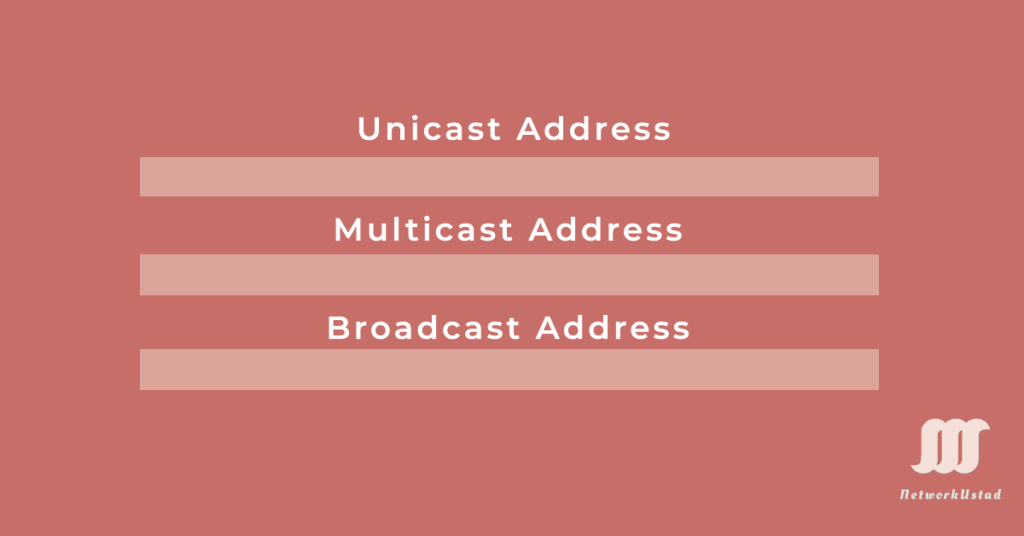Mastering Unicast, Multicast, and Broadcast Addresses in 2025
In Ethernet, Multicast, and Broadcast Addresses always describe a group of recipients. However, the unicast explains communication where data is sent from one point to another.
Unicast Address
A unicast address means a packet has been sent from a single source to a specific destination. All Ethernet and IP networks support unicast transmission. A unicast MAC address is the unique address used to send a packet from a single transmitting device to a single destination device.
A destination IP address must be in the IP packet header to send a unicast packet from the source to the destination. A destination MAC address must also be present in the Ethernet frame header. The IP and MAC addresses combine to deliver data to a specific destination.
Unicast addresses are widely used in modern applications like video streaming to individual users and remote desktop protocols as of 2025, ensuring secure and targeted data delivery.
Multicast Address
A multicast address is a logical identifier for a group of hosts in a computer network that can process datagrams or frames intended for multicasting for a designated network service. The Data link layer of the OSI model also uses a multicast address.
A multicast MAC address is a special value that begins with 01-00-5E in hexadecimal, reserved for group communication. For Ethernet and Fiber Distributed Data Interface (FDDI) media access control (MAC) addresses, the range is from 01-00-5E-00-00-00 to 01-00-5E-7F-FF-FF. The remaining portion of the multicast MAC address is created by converting the lower 23 bits of the IP multicast group address into 6 hexadecimal characters.
The range of IPv4 multicast addresses is 224.0.0.0 to 239.255.255.255. Using these addresses, a source device can send a packet to a group of devices that belong to a multicast group. These devices assign a multicast group of IP addresses. The source will also be unicast.
Online games, such as multiplayer titles popular in 2025, use multicast addresses to connect many players remotely for the same game. Another use of this address is in distance learning through video conferencing, where many students connect to the same class.
In 2025, multicast addresses are increasingly utilized in 5G networks and IoT ecosystems for efficient data distribution to groups, such as smart city sensor networks.
Broadcast Address
When a single computer sends messages to many simultaneously, it is called a broadcast. Television broadcasting is the most common example of a broadcast. Radio transmission is another example of broadcasting. In computer networking, a broadcast means the network sends one copy of a packet to each destination. A broadcast packet also contains a destination IPv4 address with all 1s in the host portion (see 172.17.255.255) in the IP Packet.
Several network protocols, including ARP, DHCP, and mDNS, rely on broadcasts for efficient device communication as of 2025. When the IPv4 broadcast packet is encapsulated in the Ethernet frame, the destination MAC address is the broadcast MAC address of FF-FF-FF-FF-FF-FF in hexadecimal, which is 48 ones in binary. Broadcast addresses remain critical in 2025 for protocols like mDNS (multicast DNS) and network discovery in home automation systems.
Conclusion
Understanding unicast, multicast, and broadcast addresses remains fundamental to navigating the evolving landscape of network communication. Unicast ensures precise one-to-one data delivery, Multicast optimizes one-to-many distribution for applications like online gaming and IoT, and broadcast facilitates efficient one-to-all messaging for protocols such as ARP and DHCP. With advancements in 5G, smart networks, and home automation, these address types continue to play a pivotal role in enhancing network efficiency and reliability. Mastering their differences and applications empowers network professionals to design robust systems, troubleshoot effectively, and adapt to the dynamic demands of modern technology.
FAQs
-
A unicast address represents a single device in the network. It is used for one-to-one communication, where data is sent from one device to a specific destination device.
